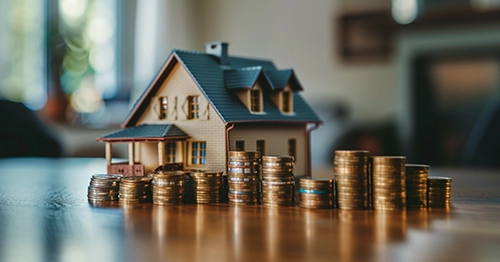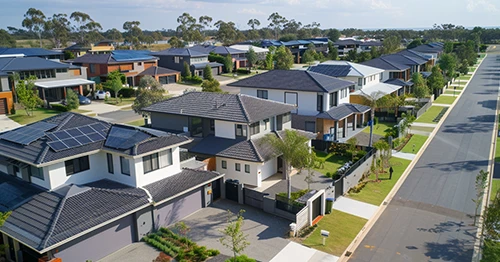Updated: 29 May, 2025
The Reserve Bank of Australia (RBA) has raised the cash rate to 2.85% with its latest 25-basis-point hike, the seventh monthly rate rise in a row. The RBA is expected to keep it up until it puts a lid on persistently high and rising inflation. These hikes have slugged borrowers with higher mortgage repayments and, for some, mortgage stress as they struggle to meet their repayments. Housing values are on a downward trend and this is likely to continue until interest rates go down. Given all this, many investors are asking themselves whether they should wait or invest in properties now. Here is a look at some factors that can be good indicators of how the market is trending, and what each might signal to potential investors.
Falling Property Prices
CoreLogic’s Home Value Index (HVI) shows that housing values declined further (-1.2%) in October nationally. The rate of nationwide decline eased, however – from -1.6% in August. Until October, Darwin was the only capital city where housing values hadn’t started to trend lower but it experienced a -0.8% fall this October. Housing values are falling faster than unit values across capital cities – -1.2% and -0.7%, respectively. CoreLogic research director Tim Lawless said it was probably still too early to claim the worst of the decline phase was over. This means we could see the rate of decline re-accelerate as interest rates rise further and household balance sheets become more thinly stretched. The fall in property prices means the market favours buyers ahead of sellers. Potential investors can take this as an opportunity if they can afford to make repayments in the current environment of rising interest rates and cost-of-living pressures.
| City | Change in dwelling values | |
|---|---|---|
| – | September | October |
| Sydney | -1.8% | -1.3% |
| Melbourne | -1.1% | -0.8% |
| Brisbane | -1.7% | -2.0% |
| Adelaide | -0.2% | -0.3% |
| Perth | -0.4% | -0.2% |
| Hobart | -1.4% | -1.1% |
| Darwin | 0.0% | -0.8% |
| Canberra | -1.6% | -1% |
| National | -1.4% | -1.2% |
Source: CoreLogic (31 October 2022)
Rental Growth Amid Record Low Vacancy Rates
Tenants are facing the toughest rental market ever, with vacancy rates falling to record low levels.
| City | Rental vacancy rates | |
|---|---|---|
| - | October 2021 | October 2022 |
| Sydney | 2.2% | 1.0% |
| Melbourne | 3.1% | 1.1% |
| Brisbane | 1.3% | 0.7% |
| Adelaide | 0.5% | 0.2% |
| Perth | 0.5% | 0.3% |
| Hobart | 0.4% | 0.3% |
| Darwin | 0.6% | 0.8% |
| Canberra | 0.8% | 1.0% |
| National | 1.5% | 0.8% |
Source: Domain
In October, the national vacancy rate fell to 0.8%, which is nearly half of what it was at the same time the previous year. This has pushed rents higher. Nationally, rents rose another 0.6% in October, led by a 1.1% rise in unit rents, while house rents increased by 0.5%. The trend towards higher rents in the unit sector is evident across most of the capital cities, which shows why demand is shifting towards more affordable rental options, such as units. Yet, even as rents continue to increase, the rate of rental growth has begun to slow. With vacancy rates remaining so low, and with added demand from overseas migration, this slowdown in rental growth is a little surprising. Lawless said it could be an early sign that renters are reaching an affordability ceiling and seeking cheaper rental options. Home Loan Experts founder Otto Dargan stated that, under these conditions – with rents and interest rates rising and property prices falling – investors who can afford to buy tend to have an edge over potential owner-occupier buyers, as interest paid on investment properties is tax-deductible, so rising rates do not affect investors as much as owner-occupiers. Based on this, some investors might consider this is a favourable time to get into the market for buying a unit.
Rising Gross Rental Yields
Investors measure gross rental yields to evaluate the income they profit from their investments and to compare the rental income from their properties. A high rental yield equates to a greater cashflow. Currently, gross rental yields remain on a rapid upwards trajectory, which is attracting experienced investors while the competition is low. Capital city gross yields (3.43%) are now at their highest level since November 2020 after rising 47 basis points since the February 2022 record low. The rapid rise in rental yields and sharp fall in house prices make a good opportunity for potential investors. Some homebuyers have even decided to buy an investment property instead of a home so that the increasing rental yield can help them with their repayments. They can move back when they can afford to do so. But expensive properties are also more affordable now. CoreLogic states that house and apartment prices in the most expensive quartile of suburbs have fallen 6.2% nationally from their April peak. While many investors are waiting to see what happens, some will secure a high-performing investment property.
Steady Fall Of Auction Clearance Rates
The auction clearance rate is a great indicator of the market situation. As a rough guide:
- >80%: It’s a seller’s market with prices rising rapidly.
- 50%-65%: The market is in equilibrium.
- <50%: It's a buyer's market with prices falling.
- Watch the above factors closely.
- Be ready to buy and pre-approved when the time looks right.
- Continue to go to open homes, as opportunities may arise.
- Get financial advice and consider how much risk you are comfortable with.
- Don’t expect to be able to buy at the absolute bottom of the market, close to it is fine.
- Lose the opportunity to buy your dream house
- Miss taking advantage of the falling property market
- Be priced out of properties in the near future that you can afford now
A change in auction clearance rates, in either direction, lets us know the market is shifting. For example, in the second week of November, the combined capitals recorded a clearance rate of 57.6%. It was 1.4 percentage points lower than the previous week’s clearance rate. By our rough guide, this suggests the market is fairly balanced but is shifting rapidly in favour of buyers. The steady fall of clearance rates indicates that sellers are starting to accept market realities and reducing their asking price amid skyrocketing interest rates and tumbling home values. Dargan says when clearance rates stop falling, that can be a sign it is the best time for some to buy. It is a good sign that the market has reached bottom. “There are two things that most people miss,” he says. “First, the changes in the auction clearance rate let you know the market is shifting. For example, if the clearance rate is falling but is doing so by less and less each week, then this lets us know the best time to buy may be approaching. Second, there is a delay between the auction clearance rate bottoming out and prices reaching their lowest point.” Note: Caution is needed in capital cities where there are not many auctions, such as Perth, Hobart and Darwin, as there may not be enough data to make a good decision. In contrast, Sydney and Melbourne have the most auctions of any capital cities, which means there is more information available for an informed decision.
Other Major Factors To Consider
The Ripple Effect
The ripple effect, the tendency of property price growth to spread across various locations starting from high-end inner cities towards the surrounding areas, is an important factor in determining the direction of the property market. It describes how price changes in one key area can propagate outwards and affect the prices in neighbouring locations. Experienced investors can get hints on what is coming by looking at the markets that are typically first-movers. Dargan says these are usually premium suburbs in Sydney. These suburbs have the most expensive 25% of houses. They are the ‘canary in the coal mine’ of the Sydney property market. Once prices rise or fall in these areas, the change then flows outward, to less expensive suburbs and then other capital cities and regional areas. So it may be a good time to buy in the outer suburbs if the expensive suburbs of a city are going up in price. Note: Caution is needed because there may be other factors at play that cause different locations to behave differently. For example, there may be a mining boom, which causes areas in Western Australia to move separately to this trend.
The Direction Of Interest Rates
The increasing rates put financial pressure on homeowners and buyers and generally lead to fall in property prices. When the RBA stops increasing interest rates, then home prices are likely to stabilise soon. Again, there may be a delay because it takes time for interest rate changes to have an effect on the market. Dargan states that when inflation appears to be under control, the RBA and economists tend to change their outlook and often begin talking of interest rate falls. This is often when experienced investors choose to buy, as they get the lowest possible home prices and may soon benefit from lower interest rates. Note: Buying a property when interest rates are high is riskier, as the economy may change again and rates may not fall. It also requires the buyer to have a high income to be able to afford the loan.
Pattern Of Crisis
An economic crisis can come at any time and often it’s the crisis that nobody sees coming that causes markets to change direction. Dargan pointed out there is a pattern that played in the property market when both the Global Financial Crisis and the COVID-19 pandemic occurred. At first, there is a denial that there is a crisis. After that, there is a fear and realisation that property prices may fall slightly and people delay selling their properties. This is followed by economic stimulus, in which central banks reduce rates, and governments print money and increase spending. The property market then reacts to the stimulus and prices rise rapidly, which causes a property boom. Experienced investors usually buy in the fear or stimulus stage, which means they get a low price and low interest rates, then benefit from growing prices. In addition to this, fixed rates may be low so they often lock in their rate for five years. Note: There are no guarantees that future crises will follow the same pattern. It’s important to get financial advice and consider risk when making investing decisions in a crisis. All information above is general in nature and should not be considered tailored personal advice.
How Can An Investor Stay Ahead Of The Trends?
Should I Invest In Property?
If you keep waiting for the right time to buy, you could:
Are you still not sure whether to buy the property now or wait until rates start to cool? Home Loan Experts’ mortgage brokers will help you make the right decisions. Call us on 1300 889 743 or enquire online today.







